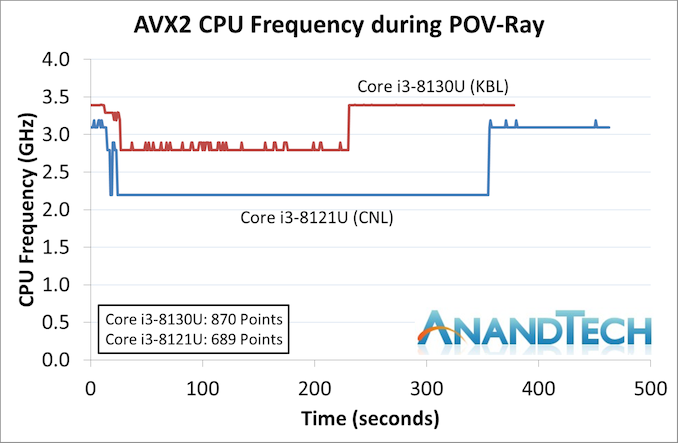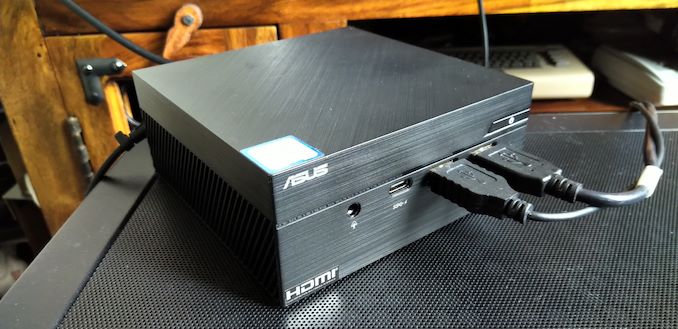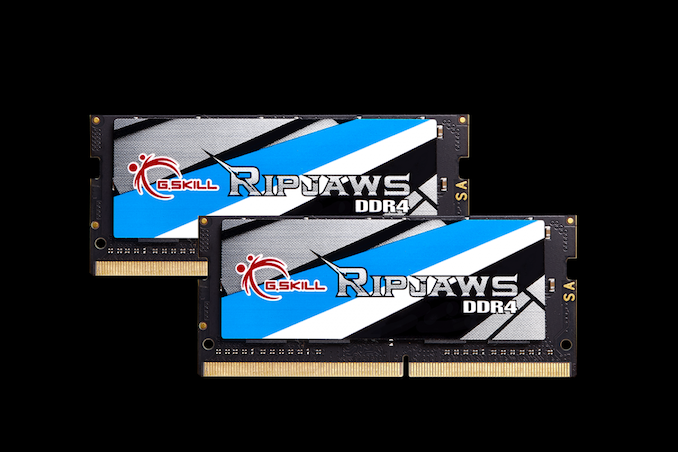Intel's 10nm Cannon Lake and Core i3-8121U Deep Dive Review
by Ian Cutress on January 25, 2019 10:30 AM ESTFrequency Analysis: Cutting Back on AVX2 vs Kaby Lake
Analyzing a new CPU family as a mobile chip is relatively difficult. Here we have a platform that is very much hamstrung by its thermal settings and limitations. Not only that, the BIOS adjustments available for mobile platforms are woeful in comparison to what we can test on desktop. This applies to the Intel NUC that came to retail in December as well as the Lenovo Ideapad E330-15ICN that we have for testing.
The issue is that for a 15W processor, even when built in a ’35 W’ capable environment, might still hit thermal limits depending on the configuration. We’ve covered why Intel’s TDP often bares little relation to power consumption, and it comes down to the different power levels that a system defines. It can also depend a lot on how the chip performs – most processors have a range of valid voltage/power curves which are suitable for that level of performance, and users could by chance either get a really good chip that stays cool, or a bad chip that rides the thermal limits. Ideally we would have all comparison chips in a desktop-like environment, such as when we tested the ‘Customer Reference Board’ version of Broadwell, which came in a desktop-like design. Instead, we have to attach as big of a cooling system as we can, along with extra fans, just in case. Otherwise potential variations can affect performance.
For our testing, we chose Intel’s Core i3-8130U mobile processor as the nearest competition. This is a Kaby Lake dual core processor, which despite the higher number in its name is using the older 14nm process and older Kaby Lake microarchitecture. This processor is a 15W part, like our Cannon Lake Core i3-8121U, with the same base frequency, but with a slightly higher turbo frequency. Ultimately this means that this older 14nm processor, on paper, should be more efficient than Intel’s latest 10nm process. Add on to this, the Core i3-8130U has active integrated graphics, while the Cannon Lake CPU does not.
Because both CPUs have turbo modes, it’s important to characterize the frequencies during testing. Here are the specifications and turbo tables for each processor:
| Comparing Cannon Lake to Kaby Lake | |||||
| 10m Cannon Lake Core i3-8121U |
AnandTech | 14nm Kaby Lake Core i3-8130U |
|||
| 2 / 4 | Cores / Threads | 2 / 4 | |||
| 15 W | Rated TDP | 15 W | |||
| 2.2 GHz | Base Frequency | 2.2 GHz | |||
| 3.2 GHz | Single Core Turbo | 3.4 GHz | |||
| 3.1 GHz | Dual Core Turbo | 3.4 GHz | |||
| 2.2 GHz | AVX2 Frequency | 2.8 GHz | |||
| 1.8 GHz | AVX512 Frequency | - | |||
The Cannon Lake processor loses frequency as the cores are loaded, and severely loses frequency when AVX2/AVX512 is applied based on our testing. Comparing that to the Kaby Lake on Intel’s mature 14nm node, it keeps its turbo and only loses a few hundred MHz with AVX2. This part does not have AVX512, which is a one up for the Cannon Lake.
The biggest discrepancy we observed for AVX2 was in our POV-Ray test.
Here the Kaby Lake processor sustains a much higher AVX2 frequency, and completes the test quicker for a 26% better performance. This doesn’t affect every test as we’ll see in the next few pages, and for AVX-512 capable tests, the Cannon Lake goes above and beyond, despite the low AVX-512 frequency. For example, at 2.2 GHz, the Kaby Lake chip scores 615 in our 3DPM test in AVX2 mode, whereas the Cannon Lake chip scores 3846 in AVX512 mode, over 6x higher.
The system we are using for the Core i3-8130 is ASUS’ PN60 Mini-PC. This device is an ultra-compact mini-PC that measures 11.5mm square and under 5cm tall. It is just big enough for me to install our standard Crucial MX200 1TB SSD and 2x4GB of G.Skill DDR4-2400 SO-DIMMs.
For the Cannon Lake based Lenovo Ideapad 330-15ICN, we removed the low-end SSD and HDD that was shipped with the design and put in our own Crucial MX200 1TB and 2x4 GB DDR4 SO-DIMMs for testing. Unfortunately we can’t probe the exact frequency the memory seems to be running at, nor the sub-timings, because of the nature of the system. However the default SPD of the modules is DDR4-2400 17-17-17.













129 Comments
View All Comments
0ldman79 - Friday, January 25, 2019 - link
This whole situation begs the question, what could Intel have gotten out of 65nm, 32nm, 22nm, etc, had they run it for five generations.I wonder if they'll do similarly on the 10nm process, punt the first time or two then knock it out of the park. Skylake was a beautiful success. Maybe Sunny Cove will be the same for 10nm.
StrangerGuy - Friday, January 25, 2019 - link
The point is Intel now needs better uarch designers lot more than process designers. Yes 10nm improvements is hard work and an interesting read...but for users they ultimately only care about end performance and perf/$, not die sizes, transistors/mm2 or manufacturing margins. If Zen 2 blows the doors off CFL would anybody even care about about Intel's process advantage? Hell not.KOneJ - Sunday, January 27, 2019 - link
Doubt this is even an "if" at this point. Curious to see if *Cove cores can keep Zen 4 and later from running away too much. Only time will tell, but Intel bringing in guys like Keller can't possibly be a bad thing. And in spite of their disastrous former attempts at building a dGPU, I fully expect Intel to make it happen this go around.eva02langley - Sunday, January 27, 2019 - link
The problem is, do you believe 7nm would be any different? Unless they implement EUV directly, I don't see it. Intel will be force, like AMD, to go fab less because their node will not be better than the competition. To add to it, it is most likely be behind in time to.zodiacfml - Saturday, January 26, 2019 - link
Great job again though it doesn't warrant it for this Intel junk. Looks like they're paying Lenovo just to use Cannon lake, usable chips that came from tuning manufacturing.The performance is where I expected it to be.
I still stand to my theory that Intel is reluctant to spend, leaving their engineers stressing if they can produce 10nm products without new equipment.
Anyways, it is a dead horse. AMD will be all the rage for 2019.
KOneJ - Sunday, January 27, 2019 - link
"Intel is reluctant to spend"To the contrary: throwing money at the problem is exactly what they're doing. Have you tracked their CAPEX these past few years?
"AMD will be all the rage for 2019."
I think that's basically a given.
zodiacfml - Sunday, January 27, 2019 - link
The reports were pretty vague and I don't remember them spending substantial money except the news that they're spending for more capacity on 14nm.AMD is pretty lukewarm for me last year. I'm certain that this year will be a lot stronger for AMD until Intel and Nvidia starts taking their customers more seriously.
KOneJ - Sunday, January 27, 2019 - link
Even for a company Intel's size, spending north of $12B a year isn't penny-pinching. I know their revenue and margins are massive, but their failings haven't been a lack of spending since SB. They've been progressively spending more than ever.YoloPascual - Saturday, January 26, 2019 - link
bUt 10nm iNtEL iS bEtTeR tHaN 7nm TSMC riGhT?KOneJ - Sunday, January 27, 2019 - link
Shouldn't your alias be yOlOpAsCuAl, wannabe troll?